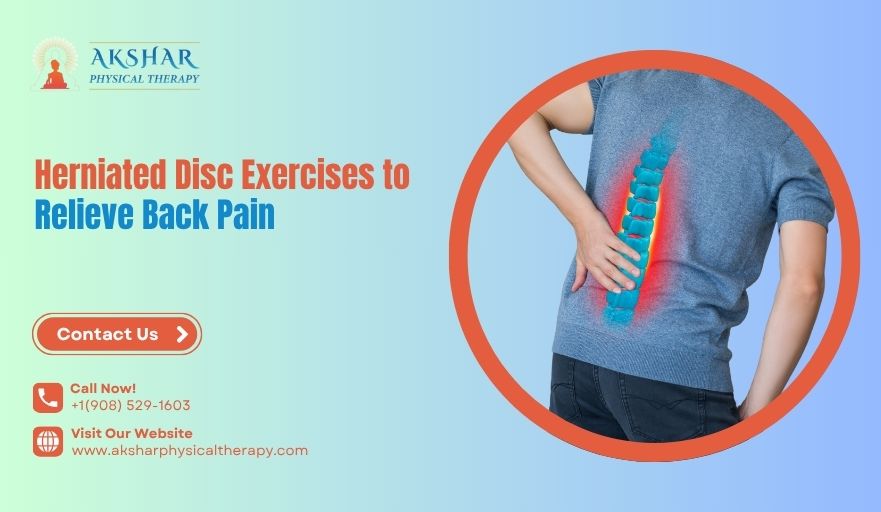If you’re suffering from back pain due to a herniated disc, you’re not alone. A herniated disc, also known as a slipped or ruptured disc, can lead to discomfort, tingling, and limited mobility. However, targeted exercises can significantly reduce pain and promote healing.
At Akshar Physical Therapy, we specialize in personalized herniated disc treatment in New Jersey, combining evidence-based therapy and expert guidance to help you recover safely and effectively.
What Is a Herniated Disc?
A herniated disc occurs when the soft center of a spinal disc pushes through a crack in the tougher exterior casing. This can irritate nearby nerves, leading to pain, numbness, or weakness, typically in the back or legs.
Benefits of Exercise for Herniated Disc
-
Reduces pressure on the spine
-
Improves flexibility and mobility
-
Strengthens supporting muscles
-
Enhances blood flow to aid healing
-
Promotes long-term spine health
5 Effective Exercises for Herniated Disc Relief
Note: Always consult a physical therapist before starting any new exercise program, especially if you’re experiencing severe symptoms.
1. Pelvic Tilts
This gentle movement strengthens your lower abdominal muscles and relieves pressure on your spine.
How to Do It:
-
Lie on your back with knees bent, feet flat on the floor.
-
Flatten your back against the floor by tightening your abdominal muscles.
-
Hold for 5 seconds and release.
-
Repeat 10–15 times.
2. Knee-to-Chest Stretch
Helps elongate the spine and relieve pressure on the discs.
How to Do It:
-
Lie on your back with both knees bent.
-
Bring one knee toward your chest, holding it with both hands.
-
Hold for 20–30 seconds, then switch legs.
-
Repeat 2–3 times on each side.
3. Bird-Dog Exercise
Improves core stability and spinal alignment.
How to Do It:
-
Start on all fours, with hands under shoulders and knees under hips.
-
Extend your right arm and left leg simultaneously.
-
Hold for 5 seconds, return to start, and switch sides.
-
Do 10 reps on each side.
4. Cat-Cow Stretch
Increases spine flexibility and promotes blood flow.
How to Do It:
-
On all fours, inhale as you arch your back (Cow), then exhale as you round it (Cat).
-
Move slowly and gently through each motion.
-
Perform for 1–2 minutes.
5. Standing Lumbar Extension
Reduces disc pressure and may alleviate radiating pain.
How to Do It:
-
Stand with your hands on your hips.
-
Gently lean back, looking up toward the ceiling.
-
Hold for 5 seconds, then return to start.
-
Repeat 10 times.
Herniated Disc Treatment in New Jersey at Akshar Physical Therapy
Our expert team at Akshar Physical Therapy offers tailored treatment plans to meet your specific needs. We combine therapeutic exercises, manual therapy, posture correction, and education to help you recover faster and prevent future issues.
FAQs: Herniated Disc Exercises
1. Can I exercise with a herniated disc?
Yes, gentle and targeted exercises can help relieve pain and promote healing. However, avoid high-impact or twisting movements unless cleared by a therapist.
2. How soon can I start exercising after a herniated disc diagnosis?
Start only after consulting your healthcare provider or physical therapist. Early movement can help, but timing and technique are critical.
3. Are these exercises safe for everyone?
Most are safe for mild to moderate cases, but some conditions require supervision. Always personalize your exercise program with a licensed therapist.
4. How often should I do these exercises?
Typically, once or twice daily is recommended, but frequency depends on your condition. Your physical therapist will guide you.
5. What if the pain gets worse after exercising?
Stop immediately and consult your physical therapist. Pain may indicate incorrect form or an unsuitable exercise for your condition. herniated disc treatmen


 Book Appointment
Book Appointment Insurance & Forms
Insurance & Forms
